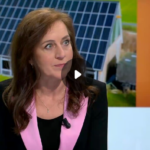Eerder schonk ik aandacht aan de magistrale voordracht van de Duitse topeconoom, Hans-Werner Sinn, directeur van het IFO Institut, onder de titel ‘Energiewende ins Nichts’. Het ging over:
‘… die Risiken und Gefahren einer politisch getriebenen Energiewende ohne ingenieurwissenschaftliche “Produktreife” und basisökonomischen Verstand im Hinblick auf rechtliche, volkswirtschaftliche und grundarithmetische Differenzen.’
Kan het nog gründlicher?
Van zijn optreden is een video gemaakt, die hier is te vinden.
Het is een indrukwekkend verhaal, maar erg technisch en een hele zit (meer dan een uur!), maar voor de energiefanaten onder ons verplichte kost.
Onlangs heeft Sinn een voordracht gehouden t.g.v. het afscheid van prof. Cees Withagen van de VU, in april 2016 in Amsterdam, onder de titel: ‘Buffering Volatility: A Study on the Limits of Germany’s Energy Revolution’.
Samenvatting
Based on the 2014 German hourly feed-in and consumption data for electric power, this paper studies the storage and buffering needs resulting from the volatility of wind and solar energy, focusing on a “double-structure-cum-storage strategy”. While buffering wind and solar energy jointly requires less storage capacity than buffering them separately, joint buffering requires a storage capacity of over 6,000 pumped-storage plants, which is 183 times Germany’s current capacity.
Taking the volatility of demand into account would not reduce storage needs, and managing demand by way of peak-load pricing would only marginally do so, given that storage is primarily needed for seasonal fluctuations.
Thus, only a buffering strategy based on double structures, i.e. conventional energy filling the gaps left in windless and dark periods, seems feasible. With this strategy, green and fossil plants would be complements rather than substitutes, contrary to widespread assumptions.
Unfortunately, however, a buffering strategy based on double structures loses its effectiveness when wind and solar production overshoots electricity demand. This is shown to happen when average wind and solar power production exceeds about one third of aggregate electricity production.
Voluminous, costly and inefficient storage devices will then be unavoidable to avoid progressively increasing efficiency losses. Buffering the overshooting production spikes associated with a market share of wind and solar of 50% would require an ideal, frictionless storage volume of 2.5 TWh or a storage capacity of 2.1 TWh in ordinary pumped-storage plants.
This is about seven times the entire pumped-storage capacity currently available in western Europe, including Norway and Switzerland; and 81% of the volume that the EU’s ESTORAGE project considers as “realisable” in western Europe. This will make it difficult for Germany to pursue its energy revolution towards green autarchy, as intended.
Aldus Hans-Werner Sinn.
Lees verder hier.
In de afsluitende opmerkingen van de hoofdtekst van zijn voordracht gaat Hans-Werner Sinn in op de onoverkomelijke moeilijkheden bij verschillende technische opties om elektriciteit op te slaan – naast opslag in stuwmeren, opslag via omzetting in methaan of waterstof. Maar deze laatste opties zijn prohibitief duur en gaan gepaard met veel energieverlies.
Zijn betoog besluit met de zin:
In view of all these difficulties, it is imperative that the world community and other EU countries carefully observe the outcome of the German experiment before mimicking it.
Dat is netjes en eufemistisch geformuleerd.
Sinn betwist niet dat het verstoken van fossiele brandstoffen tot opwarming van de atmosfeer leidt en daarom dient te worden verminderd. Zoals de trouwe lezers weten, delen wij deze opvatting niet hier op Climategate.nl. Maar voor het overige onderschrijven wij zijn analyse, die overduidelijk het surrealistische karakter van de Energiewende blootlegt – en daarmee mutatis mutandis ook dat van ons eigen nationale energieakkoord.
Voor mijn eerdere bijdragen over klimaat en aanverwante zaken zie hier, hier, hier, hier en hier.






En dat is nog maar de elektrische energie.
En dan is er nog de vraag wie in een land wil leven dat vergeven is van de windmolens.
WAT een stuk van H.W.Sinn. Als de energie deskundigen van Urgenda, Groen Links en Greenpeace dit lezen en begrijpen en hiervan de realiteit inzien en eerlijk zijn, dan hebben ze een probleem. Hoe vertel ik het mijn baas.
Dat soort orgies komen uit Never-Cleverland. Verwacht dus geen enkel berouw en/of boetedoening.
Over Greenpeace staat hier iets interessants:
http://www.eike-klima-energie.eu/2017/01/10/greenpeace-chefin-jennifer-morgan-zieht-bei-ipcc-und-pik-unbehelligt-die-strippen/
Bijsterveld
Wat dacht je van medewerkers van TNO die elektrische auto’s schoon noemen omdat ze op “groene energie” kunnen rijden.
Misschien moet je ze eens naar de volgende link verwijzen:
http://climategate.nl/2016/03/19/elektrische-autos-milieuvriendelijk/
Hugo Matthijsen.
Ik eens opgezocht hoe het TNO gefinancierd wordt.
Voor een groot deel door de overheid en verder door
de opdrachtgever voor een onderzoek/rapport.
Wiens brood men eet, diens woord men preekt.
In het stuk van H.W. Sinn is te lezen dat de ‘Energiewende’ 20 jaar geleden begon. En nu wordt 85 % van het Duitse energieverbruik nog steeds uit fossiele brandstof gewonnen.
De Duitse windmolens hebben een productiefactor van 16,3 %. En leveren 3,4 % van het totale energieverbruik.
Waar gaat dat heen?
De ‘Energiewende’ is als een schip op het strand.
En kijk eens hier: https://www.agora-energiewende.de/de/themen/-agothem-/Produkt/produkt/76/Agorameter/
de energie van zonnepanelen is amper te zien. Om te huilen toch, gezien de miljarden “investeringen”.
Deze website is trouwens een stuk eerlijker dan de onze : http://energieopwek.nl/
@David
“de energie van zonnepanelen is amper te zien.”
Hoe denk je dat dat komt, David? De hoeveelheid zonlicht is midden in de zomer 10 x zo groot als nu (midden in de winter)! En daarbij: het lijkt me dat alle stroom die lokaal opgewekt wordt en lokaal gebruikt niet in deze statistiek terecht komt. Dat gaat helemaal buiten de energiemaatschappijen om.
Als je gekoppeld bent aan het openbare netwerk dan is met het slimme gedoe het totale gebruik vastgelegd en wordt de eigen productie gesaldeerd.
[ Dat gaat helemaal buiten de energiemaatschappijen om]
Aaahhh vandaar die bruinkool.
Het is al langer duidelijk dat opslag geen haalbare kaart is voor een energievorm die niet levensvatbaar is. Opslag is trekken aan een dood paard, omdat hernieuwbare energie per definitie niet in staat is om te voldoen aan de basale eisen van onze maatschappij.
Inderdaad. Er zijn 2 scenario’s
1. De opslag variant: volledig zon en wind.
Productiecapaciteit moet ca 5 * hoger zijn (dan alleen fossiel of nucleair) zware netten, duur. Ruimtegebrek is beperkende factor.
Koppelnetten zijn onbetaalbaar.
2. Is de backup variant. Hier draaien de centrales 2 van de drie dagen. Zo’n optie is alleen aantrekkelijk als de brandstofkosten zeer hoog zijn vergeleken met de vaste kosten van de centrales. Waarschijnlijk schertsvertoning.
Toegegeven: energie opslag is haast nog ingewikkelder en complexer dan energie opwekken.
Maar wat als je hier eens totaal anders tegenaan gaat kijken?
Omdenken. What if.
Wat als je een tak van industrie uitvindt die vréselijk veel energie kost, maar die alleen maar ‘werkt’ op basis van energie overschot?
Toegegeven: ik kan zelf hier nog geen eens een voorbeeld van geven, maar denk eens aan staalsmelterijen of vergelijkbaar.
Dus een industrie tak die volgend is op het energie aanbod.
De vraag is: is dat technisch of economisch mogelijk?
Daarbij de vraag: is het mogelijk om overschot aan energie te voorspellen op basis van weersberichten, hvh zon of wind?
Aluminium kan alleen gesmolten worden door elektriciteit heb ik begrepen.
What if. Je gaat alleen alu smelten als er een overschot aan energie is.
Yep, je hebt dan nogal wat flex-werkers nodig ja!
Werkelijk geen idee of zoiets mogelijk is. Maar afkoppelen van zonnecellen of windmolens bij overschot is zowiezo al een sneue optie.
En wat te denken van stoom. Ja, ik weet het, old tech, laag rendement, maar toch kun je daar heel wat energie in kwijt. Neem vliegdekschip, vliegtuigen worden gekatapulteerd met good old steam.
Dus zelfs in een high-tech omgeving gebruikt men nog steeds old tech.
In hoeverre is het dan mogelijk/lonend om stoom te maken bij een overschot aan energie? Een stoom generator? Water opwarmen kost immers veel tijd en het is juist de factor ’tijd’ die in de weg zit bij over of onderschot (!).
En ja, het zal vast héél erg naief zijn wat ik zeg, en ja, u mag mij uitlachen hoor! :) Heb geen last van een teer zieltje.
Maar loskoppelen van het net vind ik persoonlijk niet echt getuigen van een ‘intelligente of duurzame oplossing’. Dus vandaar.
Maar hoe dan ook: er moet verdorie toch IETS te verzinnen zijn waarmee je energie overschot op een zinvolle manier kunt gebruiken of benutten?
Van plastic weer olie maken bijvoorbeeld. Verzin maar iets.
Laag rendement ja, maar beter er weer olie van maken dan gewoon verbranden.
“Plastic to Oil Conversion “Plastic into black gold” -Panasonic ecoideasnet ”
https://www.youtube.com/watch?v=6W5wEAbp9o8
@Wiersma:
“Maar loskoppelen van het net vind ik persoonlijk niet echt getuigen van een ‘intelligente of duurzame oplossing’.”
Het loskoppelen van het net getuigt juist van intelligentie: de problematiek van de bestendigheid leg je dan bij de “duurzame” opwekker/gebruiker en niet bij de nietsvermoedende consument.
Wiersma
Ga eens bij een hoogoven of staalsmelterij kijken.
Als er geen of te weinig energie is dan stolt de zaak en kun je je productie-eenheden ontmantelen .
“Sinn betwist niet dat het verstoken van fossiele brandstoffen tot opwarming van de atmosfeer leidt en daarom dient te worden verminderd. Zoals de trouwe lezers weten, delen wij deze opvatting niet hier op Climategate.nl. Maar voor het overige onderschrijven wij zijn analyse, …”
Wat moet het leven heerlijk zijn, als je zo schaamteloos kan sjoppen in wat je wel en niet aanneemt, kennelijk zonder ook maar enig respect voor feiten en wetenschappelijke tucht. :)
kijk eens hier Joris: http://www.thebestschools.org/special/karoly-happer-dialogue-global-warming/william-happer-interview/
volgens deze geleerde is het beter de CO2 concentratie nog een factor 3 te verhogen tot het peil dat ook in onze kassen en huiskamers gebruikelijk is.